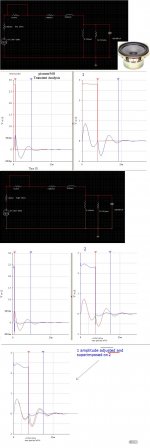Iv'e been studying alot about subwoofer/driver design, and i want to know more. As much as i can.
Things i am wondering about:
I've always wondered if "eddy-current" and back EMF is the same. I also have wondered if eddy-current from inductance of the coil is where the damping QES of the coil comes from, because i see damping as resistance, be it from a stiff spider, or eddy-current induced in the coil to damp the motion of the coil. So when people say that a strong motor force is better for Qes damping, i wonder if it is because a stronger motor force causes more eddy-current?
Also, i hear that a fully conductive former without a break increases Mechanical damping because it creates more back-EMF for better restoring. Well, this is strange to as it seems that this effect would be attributed to better Electrical dampening instead of being dubbed mechanical, but i can undertand when i see people use the shorting terminal analogy.
With this, my theory is that the difference between Qes, and Qms is that Qms is constantly mechanically provided, whereas, Qes is only provided when the sub is active? From the coil?
Just need a little help undertanding the diff between those two.
Or am i wrong that indcutance from the coil is even helpfull in Electrical damping and that it actually messes it up, and that it is the opposite?
Any lecture on inductance correlating to other things like impedance, and what a box will do to change behavior of impedance etc is what i am after. But i already understand about Qs in relations to boxes, i want to know everything about the relationship of inductance, impedance, back emf, diaphram ecursion displacement, etc...
And i also wonder why woofers with longer xmax is better for creating a louder low-end when i read that voltage is what determines xmax. I mean i know that with a ported box, at Fb, displacment is at minumum because port, but idk why longer xmax means louder low-end. Probly because more air-movement, but why does the lower end want more air movement then the upper freqs to get just as loud?
Also my biggest point of wonder is how does impedance change everything, and is this why the low-end is less eficient? or does it have to do with a longer travel being less eficient? I figure that a longer travel causes more impedance rise so this is probly why, but i don't really know why the lows want a longer xmax in general, and if this has to do with impedance?
I read one time that Q is what causes bass, because resonance is bass, and also heard q being corelated to higher impedance, but which one comes first? i figure it to be Q because because it causes more inductance and i am assuming now that inductance is exactly what causes impedance rise?
So is inductance the exact cause of impedance rise? Meaning that a woofer with less inductance will have less Q?
Sorry for the long post...help me out.
Things i am wondering about:
I've always wondered if "eddy-current" and back EMF is the same. I also have wondered if eddy-current from inductance of the coil is where the damping QES of the coil comes from, because i see damping as resistance, be it from a stiff spider, or eddy-current induced in the coil to damp the motion of the coil. So when people say that a strong motor force is better for Qes damping, i wonder if it is because a stronger motor force causes more eddy-current?
Also, i hear that a fully conductive former without a break increases Mechanical damping because it creates more back-EMF for better restoring. Well, this is strange to as it seems that this effect would be attributed to better Electrical dampening instead of being dubbed mechanical, but i can undertand when i see people use the shorting terminal analogy.
With this, my theory is that the difference between Qes, and Qms is that Qms is constantly mechanically provided, whereas, Qes is only provided when the sub is active? From the coil?
Just need a little help undertanding the diff between those two.
Or am i wrong that indcutance from the coil is even helpfull in Electrical damping and that it actually messes it up, and that it is the opposite?
Any lecture on inductance correlating to other things like impedance, and what a box will do to change behavior of impedance etc is what i am after. But i already understand about Qs in relations to boxes, i want to know everything about the relationship of inductance, impedance, back emf, diaphram ecursion displacement, etc...
And i also wonder why woofers with longer xmax is better for creating a louder low-end when i read that voltage is what determines xmax. I mean i know that with a ported box, at Fb, displacment is at minumum because port, but idk why longer xmax means louder low-end. Probly because more air-movement, but why does the lower end want more air movement then the upper freqs to get just as loud?
Also my biggest point of wonder is how does impedance change everything, and is this why the low-end is less eficient? or does it have to do with a longer travel being less eficient? I figure that a longer travel causes more impedance rise so this is probly why, but i don't really know why the lows want a longer xmax in general, and if this has to do with impedance?
I read one time that Q is what causes bass, because resonance is bass, and also heard q being corelated to higher impedance, but which one comes first? i figure it to be Q because because it causes more inductance and i am assuming now that inductance is exactly what causes impedance rise?
So is inductance the exact cause of impedance rise? Meaning that a woofer with less inductance will have less Q?
Sorry for the long post...help me out.

Read this
http://www.volvotreter.de/downloads/what-is-Q.pdf
"and is this why the low-end is less eficient?"
This has to do with the impedance(or resistance) of air. It is simply much harder to create any pressure at low frequencies with a small surface. This it has to move further.
Try to grab air with your hand. The faster you wave it back and forth the more "wind" you will feel. The higher the frequency gets as well.
This is a change of 12dB per octave.
"So is inductance the exact cause of impedance rise?"
Reactance, both mechanical and electrical.
"Meaning that a woofer with less inductance will have less Q?"
Inductance only comes to "play" at higher frequencies. Unless it becomes large at which point it becomes a problem.
Back EMF is simply the mechanical force from the cone converted to electrical force (current and voltage) due to the motor acting as a generator every time the applied electrical force don't coincide with the cones current force.
To change a cones acceleration you ether give current to it or sip current from it. (which is dissipated by the crossover and (mostly) the amplifier) along with the losses (resistance) in the speaker.
Not sure if I got everything right but I guess someone will correct it then.
http://www.volvotreter.de/downloads/what-is-Q.pdf
"and is this why the low-end is less eficient?"
This has to do with the impedance(or resistance) of air. It is simply much harder to create any pressure at low frequencies with a small surface. This it has to move further.
Try to grab air with your hand. The faster you wave it back and forth the more "wind" you will feel. The higher the frequency gets as well.
This is a change of 12dB per octave.
"So is inductance the exact cause of impedance rise?"
Reactance, both mechanical and electrical.
"Meaning that a woofer with less inductance will have less Q?"
Inductance only comes to "play" at higher frequencies. Unless it becomes large at which point it becomes a problem.
Back EMF is simply the mechanical force from the cone converted to electrical force (current and voltage) due to the motor acting as a generator every time the applied electrical force don't coincide with the cones current force.
To change a cones acceleration you ether give current to it or sip current from it. (which is dissipated by the crossover and (mostly) the amplifier) along with the losses (resistance) in the speaker.
Not sure if I got everything right but I guess someone will correct it then.
Here's why bass needs so much displacement:
Our ears don't hear the amplitude of the signal (ie, the displacement, peak). We hear the rate of change of pressure - the *steepness* of the wave (the angle at which the wave ).
Look at the attachment. The red and black curves (red being a higher frequency) are of roughly equal magnitude. However, we'd hear the red wave as much louder than the black one, as the uptake is much steeper. The black and green lines, however, are roughly the same steepness, so they'd be heard as about the same volume. However, the black line is of much greater magnitude, so much more displacement is needed to get those low frequencies.
Chris
Our ears don't hear the amplitude of the signal (ie, the displacement, peak). We hear the rate of change of pressure - the *steepness* of the wave (the angle at which the wave ).
Look at the attachment. The red and black curves (red being a higher frequency) are of roughly equal magnitude. However, we'd hear the red wave as much louder than the black one, as the uptake is much steeper. The black and green lines, however, are roughly the same steepness, so they'd be heard as about the same volume. However, the black line is of much greater magnitude, so much more displacement is needed to get those low frequencies.
Chris
Attachments
Thanks for the replies..
As far as electrical damping goes, the link says that it is the dc resistance, and amp damping factor. Is this correct? Because i thought it had to do with how strong the motor force is...But am not sure how it physically would make for better damping. I guess that a strong motor force is like HP in a motor, it can change directions faster i guess, but dnt see this resisting a single downward or upward stroke at f0. Idk..
As far as electrical damping goes, the link says that it is the dc resistance, and amp damping factor. Is this correct? Because i thought it had to do with how strong the motor force is...But am not sure how it physically would make for better damping. I guess that a strong motor force is like HP in a motor, it can change directions faster i guess, but dnt see this resisting a single downward or upward stroke at f0. Idk..
..As far as electrical damping goes, the link says that it is the dc resistance, and amp damping factor. Is this correct? ..
Hi Huricane,
 ..Yes, because the maximum dissipation rate of speaker reactive stored energy occurs at the signal zero crossing point where the driver reactive stored energy is shunted by the driver resistance Re in series with the amplifier output impedance(i.e. resistance= Rg).
..Yes, because the maximum dissipation rate of speaker reactive stored energy occurs at the signal zero crossing point where the driver reactive stored energy is shunted by the driver resistance Re in series with the amplifier output impedance(i.e. resistance= Rg).Thats why a Voltage type of amp with low output impedance( Rg considered negligible with respect to Re): damps the speaker at a faster rate than a high Z-out amp would do .
If Rg > = 0: Qes would actually being increased as being modified = multiplied by the factor of(1+Rg/Re) instead of normally only being direct depending on just the Re value.
b🙂
hmmm...Strange. If this is true, dosn't it indicate that the amplifier will change what size box needed, and how the sub will act? Like the qts being changed based on the amp, and a 2 vs 4ohm coil? Isn't there something else to Qes?
Besides that, iv'e been studdying reactance/impedance. I realize how a capacitor will block lower frequencies, hence the impedance peak at resonance free-air. But in loudspeakers(subwoofer specifically) is the "capacitor" in this case mechanical? Like instead of the coil causeing capacitance, is it the MMS, and suspension that cause it? Or is it the coil aswell?
Also, if there is an impedance peak so high at fs, how is it that a subwoofer moves most efficiently, and the most at it? I have heard something about the physics of the mmd coming to balance with the suspension, but i need more explanation specifically.
Iv'e never had a pyhsics class before, but i can understand it if you can help me out..Analogies are great..
Besides that, iv'e been studdying reactance/impedance. I realize how a capacitor will block lower frequencies, hence the impedance peak at resonance free-air. But in loudspeakers(subwoofer specifically) is the "capacitor" in this case mechanical? Like instead of the coil causeing capacitance, is it the MMS, and suspension that cause it? Or is it the coil aswell?
Also, if there is an impedance peak so high at fs, how is it that a subwoofer moves most efficiently, and the most at it? I have heard something about the physics of the mmd coming to balance with the suspension, but i need more explanation specifically.
Iv'e never had a pyhsics class before, but i can understand it if you can help me out..Analogies are great..
Last edited:
Just think of the impedance being electrically how stiff the speaker is to move. At resonance it is at its most easy to move, so the impedance is at its highest. Resonance is all the different parts of the speaker coming together to kind of swing in time.
Would help if you could be more specific...Just think of the impedance being electrically how stiff the speaker is to move. At resonance it is at its most easy to move, so the impedance is at its highest. Resonance is all the different parts of the speaker coming together to kind of swing in time.
And if the speaker is at its easiest to move, and the impedance is how stiff it is to move it, then how does that coincide?
I can see that the speaker will move easiest at res, and i assume that the impedance comes after alot of movement? Which one comes first? And am i wrong? I can handle specific details, it would be nice to have them, even if it took a whole page.
The impedance is high at resonance. This means there's minimal current required to get the cone moving. Therefore, the cone is said to be easy to move.
For example,
The resonance is around 33Hz (where the peak of the impedance is - this one happens to be off the top of the graph). If we were to add mass (or make the suspension more compliant), the resonance would drop, resulting in a peak in impedance lower down the chart (maybe at 20Hz, you'd have to measure it).
Imagine pushing a swing. Its resonance is, lets say, 1Hz. This means it's easiest to swing it at one cycle (once forward, once backward, back to rest) per second. It's easy to keep the swing moving at its resonant frequency. Now you try swinging it at a different frequency. Keep hold of it, and try to swing it twice as fast (in terms of cycles, not speed). It's much more difficult to keep it going.
Replace the swing with a cone, replace yourself with a coil in a magnetic field, and there's your speaker. In the first part, at resonance, the impedance can be said to be very high, so there's minimal current (in this case, physical effort). When operating at another frequency, the impedance is much lower, resulting in much more current, or physical effort.
Chris
For example,
An externally hosted image should be here but it was not working when we last tested it.
The resonance is around 33Hz (where the peak of the impedance is - this one happens to be off the top of the graph). If we were to add mass (or make the suspension more compliant), the resonance would drop, resulting in a peak in impedance lower down the chart (maybe at 20Hz, you'd have to measure it).
Imagine pushing a swing. Its resonance is, lets say, 1Hz. This means it's easiest to swing it at one cycle (once forward, once backward, back to rest) per second. It's easy to keep the swing moving at its resonant frequency. Now you try swinging it at a different frequency. Keep hold of it, and try to swing it twice as fast (in terms of cycles, not speed). It's much more difficult to keep it going.
Replace the swing with a cone, replace yourself with a coil in a magnetic field, and there's your speaker. In the first part, at resonance, the impedance can be said to be very high, so there's minimal current (in this case, physical effort). When operating at another frequency, the impedance is much lower, resulting in much more current, or physical effort.
Chris
The impedance is high at resonance. This means there's minimal current required to get the cone moving. Therefore, the cone is said to be easy to move.
For example,
An externally hosted image should be here but it was not working when we last tested it.
The resonance is around 33Hz (where the peak of the impedance is - this one happens to be off the top of the graph). If we were to add mass (or make the suspension more compliant), the resonance would drop, resulting in a peak in impedance lower down the chart (maybe at 20Hz, you'd have to measure it).
Imagine pushing a swing. Its resonance is, lets say, 1Hz. This means it's easiest to swing it at one cycle (once forward, once backward, back to rest) per second. It's easy to keep the swing moving at its resonant frequency. Now you try swinging it at a different frequency. Keep hold of it, and try to swing it twice as fast (in terms of cycles, not speed). It's much more difficult to keep it going.
Replace the swing with a cone, replace yourself with a coil in a magnetic field, and there's your speaker. In the first part, at resonance, the impedance can be said to be very high, so there's minimal current (in this case, physical effort). When operating at another frequency, the impedance is much lower, resulting in much more current, or physical effort.
Chris
Thankyou very much. Thats was the most helpful answer....
So, when at res of a woofer, the coil dosnt have to drive the cone as much because the mass of the cone and the compliance(spring effect) of the spider/surround will be like gravity with the mass of the cone...
With this, say i do a a tone sweep of 25hz which happens to be the res freq of the woofer, and the time is nonstop. How does this look to the amplifier in terms of impedance, i mean, if i play it forever, will the impedance constantly be at its peak ohms measurment with no real fluctuation as long as it plays?
Like, if the wave from an audio singnal is 25 hz for 1 second as part of the dynamic overall song variation, and lets say the cross-section in time on a graph to measure it.....Idk, just let me know anything else there could be learned about it...This really helped 🙂
Thankyou very much. Thats was the most helpful answer....
So, when at res of a woofer, the coil dosnt have to drive the cone as much because the mass of the cone and the compliance(spring effect) of the spider/surround will be like gravity with the mass of the cone...
You mean the mass of the swing (at the end), but yeah. The coil contributes minimally because the cone "wants" to reproduce that frequency itself.
With this, say i do a a tone sweep of 25hz which happens to be the res freq of the woofer, and the time is nonstop. How does this look to the amplifier in terms of impedance, i mean, if i play it forever, will the impedance constantly be at its peak ohms measurment with no real fluctuation as long as it plays?
The resonance of the driver will stay the same. If you really, really push the excursion, the coil could leave the magnetic gap, the suspension would get tighter (general term: non-linearities) and the whole thing would change (though only briefly, when the cone is at it's furthest from rest). But that shouldn't happen with a properly designed driver, operating within it's limits. You have to physically alter the driver to move the resonance around.
Like, if the wave from an audio singnal is 25 hz for 1 second as part of the dynamic overall song variation, and lets say the cross-section in time on a graph to measure it.....Idk, just let me know anything else there could be learned about it...This really helped 🙂
If any of this has confused you (and I'd understand if it might), feel free to ask.
You're welcome. Your feedback is also much appreciated.
Chris
PS - if you wanted to rig up a mini-experiment to play around with resonance vs compliance and mass, get some elastic bands and some blu-tack/ play-dough or whatever you might call it. Putty, perhaps? I don't know... You'll also need a plank with a couple of nails in it, maybe 5" apart. Stretch a band across it, add some mass, see how it vibrates. Add more, see if it goes faster or slower. Much much easier to see than with speaker cones.
..rig up a mini-experiment to play around with resonance vs compliance and mass,...Much much easier to see than with speaker cones...
Hi.
I tried too but played with 'Multisim' instead and generated a bunch of pictures,😱 as usual😀
b🙂
Attachments
-
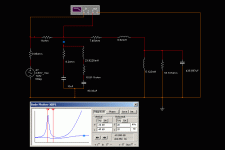 a_fs.GIF22 KB · Views: 128
a_fs.GIF22 KB · Views: 128 -
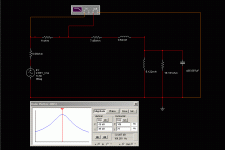 b_fs-1.GIF20.3 KB · Views: 135
b_fs-1.GIF20.3 KB · Views: 135 -
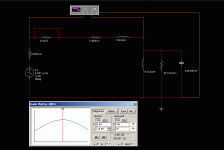 c-fs-2.GIF20.2 KB · Views: 122
c-fs-2.GIF20.2 KB · Views: 122 -
 2-Pioneer-568_NSB-FR-driver-not-Zcompensated.GIF27.2 KB · Views: 73
2-Pioneer-568_NSB-FR-driver-not-Zcompensated.GIF27.2 KB · Views: 73 -
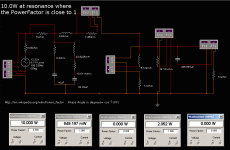 1-Pioneer-568_NSB-FR-driver-fully-Zcompensated.GIF31.4 KB · Views: 114
1-Pioneer-568_NSB-FR-driver-fully-Zcompensated.GIF31.4 KB · Views: 114 -
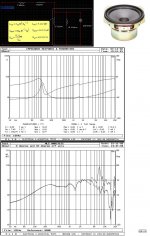 0-4inch-NSB_PE_269-568.JPG193.3 KB · Views: 123
0-4inch-NSB_PE_269-568.JPG193.3 KB · Views: 123 -
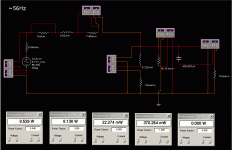 3-Pioneer-568_NSB-FR-driver-not-Zcompensated-0.5fs.GIF29.5 KB · Views: 67
3-Pioneer-568_NSB-FR-driver-not-Zcompensated-0.5fs.GIF29.5 KB · Views: 67 -
 4-Pioneer-568_NSB-FR-driver-not-Zcompensated-2fs.GIF28.7 KB · Views: 60
4-Pioneer-568_NSB-FR-driver-not-Zcompensated-2fs.GIF28.7 KB · Views: 60 -
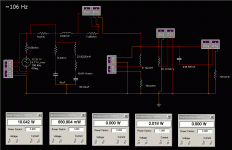 5-Pioneer-568_NSB-FR-driver-Zcompensated-fs.GIF29.7 KB · Views: 68
5-Pioneer-568_NSB-FR-driver-Zcompensated-fs.GIF29.7 KB · Views: 68 -
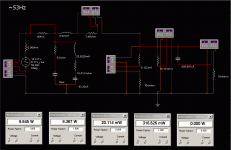 6-Pioneer-568_NSB-FR-driver-Zcompensated-0.5fs.GIF30.1 KB · Views: 67
6-Pioneer-568_NSB-FR-driver-Zcompensated-0.5fs.GIF30.1 KB · Views: 67
Hi.
I tried too but played with 'Multisim' instead and generated a bunch of pictures,😱 as usual😀
b🙂
I am always amazed at the rate of your picture generation, and how much time you'll spend explaining them.
As someone that can't get a graph out of Hornresp, I greatly respect your ability to fine-tune enclosures so quick.
- Status
- Not open for further replies.
- Home
- Loudspeakers
- Subwoofers
- Trying to undertand subwoofer behavior more..


